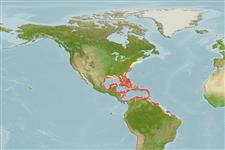Classification / Names
Common names from other countries
Main reference
Size / Weight / Age
Max length : 75.0 cm TL male/unsexed; (Ref. 9710); common length : 50.0 cm TL male/unsexed; (Ref. 55); max. published weight: 14.0 kg (Ref. 9710)
Length at first maturity
Lm 31.0, range 21 - 25 cm
Environment
Marine; reef-associated; depth range 20 - 200 m (Ref. 9626), usually 80 - 150 m (Ref. 55)
Climate / Range
Subtropical, preferred ?; 42°N - 3°S, 100°W - 40°W (Ref. 55227)
Distribution
Western Atlantic: as far north as North Carolina, USA and Bermuda south to Trinidad and northern Brazil; including the Gulf of Mexico (Ref. 9626). Very common in the Caribbean, particularly the Antilles.
Countries | FAO areas | Ecosystems | Occurrences | Introductions
Short description
Dorsal
spines
(total): 10;
Dorsal
soft rays
(total): 14;
Anal
spines: 3;
Anal
soft rays: 8. Preopercular notch and knob weak. Scale rows on back rising obliquely above lateral line. Mainly scarlet red, silvery on lower sides and belly; fins are yellowish to orange. A prominent black blotch is at the base and in axil of pectoral fins.
IUCN Red List Status (Ref. 115185)
Threat to humans
Reports of ciguatera poisoning (Ref. 55)
Human uses
Fisheries: commercial
More information
ReferencesAquacultureAquaculture profileStrainsGeneticsAllele frequenciesHeritabilityDiseasesProcessingMass conversion
Tools
Special reports
Download XML
Internet sources
Estimates of some properties based on models
Phylogenetic diversity index
PD50 = 0.5000 many relatives (e.g. carps) 0.5 - 2.0 few relatives (e.g. lungfishes)
Trophic Level
3.9 ±0.57 se; Based on food items.
Resilience
Medium, minimum population doubling time 1.4 - 4.4 years (K=0.10-0.70)
Vulnerability
High vulnerability (62 of 100)
Price category
